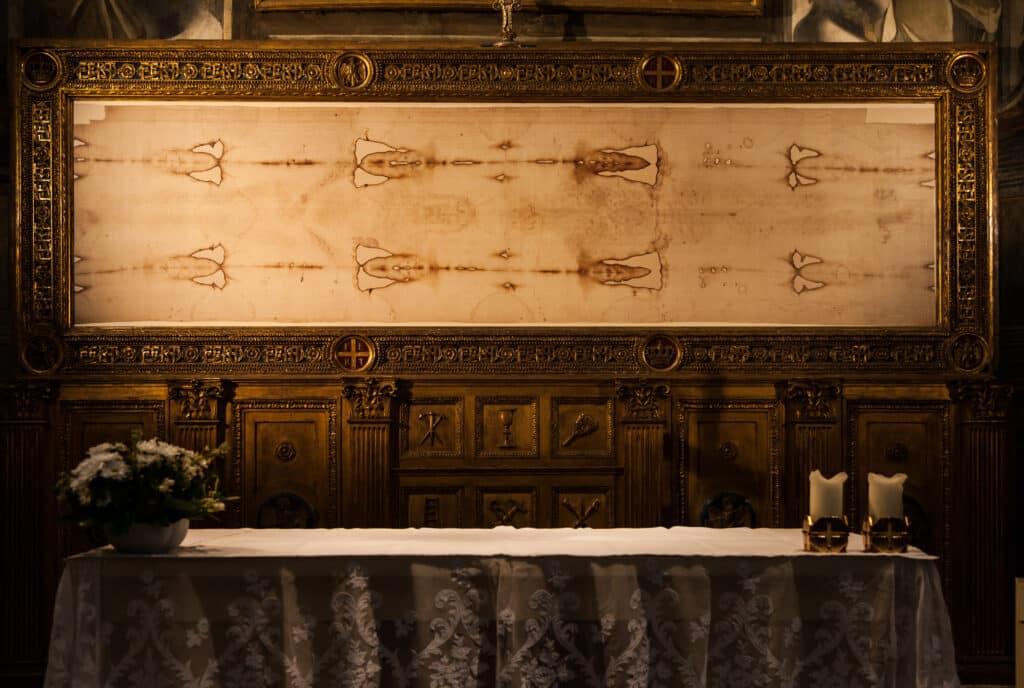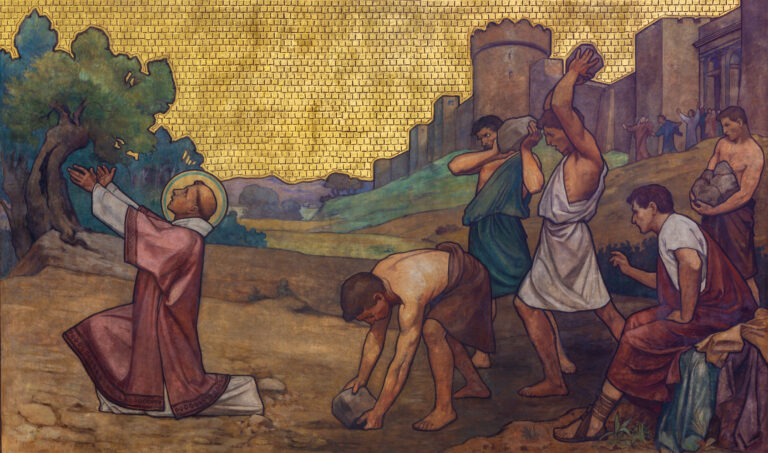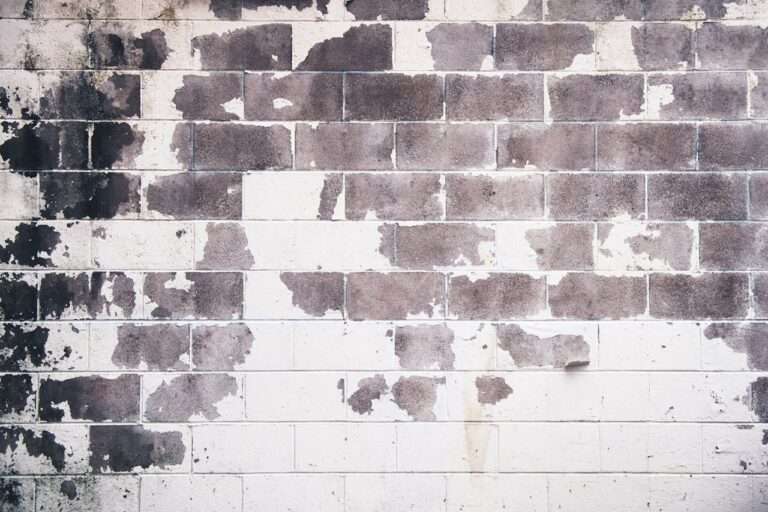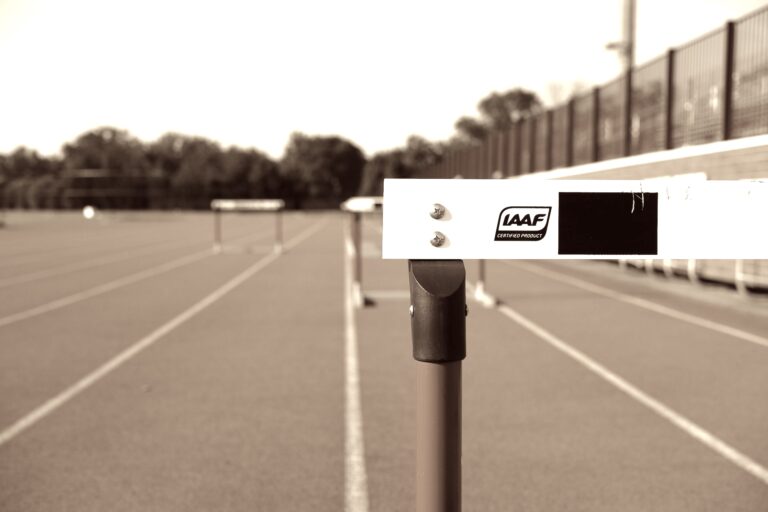“And when he learned from the centurion that he was dead, he granted the corpse to Joseph. And Joseph bought a linen shroud, and taking him down, wrapped him in the linen shroud and laid him in a tomb that had been cut out of the rock. And he rolled a stone against the entrance of the tomb.” (Mark 15:45-46, ESV)
“But Peter rose and ran to the tomb; stooping and looking in, he saw the linen cloths by themselves; and he went home marveling at what had happened.” (Luke 24:12, ESV)
In the spring of 2014, I saw my dad cry—a rare sight for me, his son.
I saw many people cry along with my dad, upon reaching the end of our pilgrimage in Santiago, Spain, the “Camino De Santiago,” or “The Way of Saint James.” This five-hundred-mile hike from the French Pyrenees to northwestern Spain is one of the few pilgrimages still popular in the world. My dad and I walked the last hundred miles of the Camino that year, carrying nothing but our backpacks and what they could hold.
The Camino consists of a long and winding walk more than a thousand years old, ending at the cathedral of St. James, which holds, so it is claimed, the bones of James, the son of Zebedee and brother of John. For centuries, the winding walk was traveled by European Christians to honor St. James, to pay penance for a sin, or to fulfill a vow.
“Stooping and looking in, he saw the linen cloths by themselves.”
Today, most who walk the Camino have other reasons, and many probably don’t care about the authenticity of the bones held there—we didn’t. They walk Camino for their own spiritual reasons: to quit smoking, to forget a bad relationship, to find courage, or just to have fun. Hundreds of thousands have walked the Camino, looking for or wanting to forget something. And when they arrive, well, it’s very emotional.
Whatever one’s reasons for walking the camino, the pilgrimage demonstrates one thing: Relics of the Christian past, whether real or fake, have power over people. Thousands of people, believers and unbelievers, still weep when they enter the church.
The reason is this: we like connections to the Christian past. And among those connections, there is nothing quite like the Shroud of Turin.
What is the Shroud of Turin?
In the same way many of us keep mementos from important moments in our lives individually, so our group identity of Christianity has kept important mementos in our story. This is more and more the case the farther back you go. For Israel, these physical connections to the past often served as reminders of how God has acted throughout history for his people (Exodus 16:33-34, Joshua 4:20-24).
That Jesus was wrapped in a shroud after his crucifixion is attested to in all four Gospels, making Jesus’ burial shroud a significant element of the Gospel story (see Matthew 27:59-60, Mark 15:45-46, Luke 23:52-53, John 19:40, 20:5-7). Further, it would not be surprising if the church had saved the burial cloth of Jesus, since, after all, the resurrection was the central event of the Christian message. According to the The Cathedral of St. John in Turin, Italy, the Shroud Jesus was wrapped and buried in has been successfully preserved, and we can go there and see it. It has become known as the “Shroud of Turin.”
“That Jesus was wrapped in a shroud after his crucifixion is attested to in all four Gospels, making Jesus’ burial shroud a significant element of the Gospel story.”
The Shroud of Turin is a stretch of cloth, 14.5’ long and 3.5’ wide. But it’s not just an old shroud which is supposedly the one Jesus was wrapped in when He was buried. It is a shroud with the imprint of a man left on it. This man is covered in marks that display lashes of a whipping/flogging, deep nail wounds through his wrists and feet, and small puncture wounds encircling his scalp. This man’s imprint also has a larger piercing wound in the man’s side. There are blood stains on the Shroud in addition to the imprint at the place of these wounds.
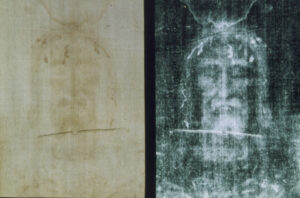
On the left is the face of Shroud Man. On the right is a negative photo of the face’s imprint on the Shroud. When editing photos of the face to try to more accurately see what the shroud man looked like, people almost always start by editing the photo into its inverse/negative. We will come back to what a negative image is later.

This is a picture of the full shroud spread out. The full body would have been wrapped in it. The front of the man’s body on the bottom half, on the top is the back of the man.

This is the same image with wounds pointed out.
“There are blood stains on the Shroud in addition to the imprint at the place of these wounds.”
The Shroud of Turin is known as a “relic.” Relics are sacred objects from our history. Among evangelicals in the West today, relics are typically associated with the Roman Catholic Church. This is partially due to the fact that the Church in Western Europe acquired a great deal of the relics in the East in exchange for help in the Crusades. Historically though, relics are not limited to one group of Christians but have had a long and significant role throughout the history of the whole of Christianity (and throughout the Old Testament before that), all the way up to Protestantism. It’s worth mentioning that, although the Shroud of Turin is considered a relic, it is not officially recognized as authentic by the Catholic Church, which has taken no official stance on its authenticity.
Because of the imprint, the Shroud of Turin is simply not comparable to any other relic around. The body’s imprint and injuries sustained are visible enough from the Shroud for the corpse to accurately be recreated and displayed, as several have done.[1] The Shroud has increasingly been in the news as new tests date it roughly to 2000 years old, and multiple tests heavily suggest that it’s from and was buried in Judea (these we will return to in a moment).
If this really was Jesus’ burial shroud, then we have an image of what Jesus looked like. We would know His height (5’7”, which is on the taller side in His day), His blood type (AB positive), that His hair was fairly long by our standards and He was bearded. And we would have the exact picture of the central moment of the faith celebrated on Easter and beyond.
A History of the Shroud
“And His image having been imprinted upon the linen, He gave it to Ananias, saying: Give this, and take back this message, to him that sent thee: Peace to thee and thy city! For because of this I am come, to suffer for the world, and to rise again, and to raise up the forefathers.” —The apocryphal Acts of the Holy Apostle Thaddaeus
In 1349, Geoffrey de Charny built the church St. Mary of Lirey in France and then publicly displayed what he claimed to be the shroud that Jesus was buried in. This shroud would end up being taken to Italy, eventually settling in Turin; hence what it’s known as now, the “Shroud of Turin.” Only a few years after displaying the Shroud, Geoffrey de Charny died in the 100 Years War.
Sadly, there are few surviving records about the man, and no records saying where he acquired the Shroud have survived. So to learn its history before its first undisputed appearance, we must study the history of other people throughout Christianity claiming to have the shroud that Jesus was buried in, and ask if connections can be made to the Shroud of Turin. As we will see, there is a reasonable though not definitive chain of events linking the Shroud of Turin to the early church.
“There is a reasonable though not definitive chain of events linking the Shroud of Turin to the early church.”
The Shroud displayed in Turin, which appeared in France in 1349, is very likely to be the same as a shroud purported to be Jesus’ burial shroud which was kept in Edessa (and later taken to Constantinople). This shroud also happened to have an imprint of the crucified corpse’s image on it. The descriptions of this shroud and its imprint match the appearance of the Shroud of Turin.[2] If the Shroud of Turin has been preserved for 2000 years, as recent tests have suggested, then it’s hard to imagine two shrouds with an imprint of a crucified man being preserved at the same time.
One of the most well-established traditions among the earliest generations of Christianity is that a king of Edessa (modern Odessa, Turkey) converted to Christianity sometime in the first century. One of the most famous stories among the earliest generations of Christianity is that the true image of what Christ looked like was brought to the king of Edessa (traditionally said to be brought by the apostle Thaddeus). One source claims the true image of Christ was painted and brought to the king, but others emphasize the image was not painted or made by human hands at all. One early source claims it was an imprint of Jesus’ face on a towel.
The earliest sources offer little clarity as to what this image in Edessa actually was. But after the age of persecutions was over, Edessa went public about their image. They would claim the image they have was the shroud Christ was buried in, which contained an imprint of Jesus miraculously made when He resurrected.[3] The cloth would be used and celebrated in Easter ceremonies for centuries in Edessa and later in Constantinople.
“The cloth would be used and celebrated in Easter ceremonies for centuries in Edessa and later in Constantinople.”
It is not far-fetched to suggest the Edessa shroud could have come from the apostolic generation. If in the time of the apostles the king of Edessa converted as the sources claim, he would logically be the ideal candidate for keeping a valuable object safe in a world of persecutions and the soon-to-begin destruction of Judea by Rome. (Edessa was just north of Judea, above the region of Syria and near Damascus and Antioch.) The upheaval also makes sense of why the king would desire to hide the shroud from public knowledge until it was clear that the age of persecution was over, where it was both common and widespread to destroy Christians’ property. Hence, this could be why there are only rumors of Christ’s image being preserved in Edessa in the earliest generations.
Once it was made public, all describe the image using similar descriptions. It was obviously memorable, as it was a unique image. It is described in details which match the Shroud of Turin: a full body of a crucifixion victim made on a cloth in an abnormal imprint and clearly not made by paint or dyes. The size of the cloth they describe matches the size of the Shroud of Turin. It also contained blood stains and wound marks.
There is additional evidence that this shroud from Edessa is the same as the Shroud of Turin. The shroud in Edessa was folded up four times and framed so that only the imprint of Christ’s face was visible. The Shroud of Turin itself has crease-marks from having been kept folded up four times for a long period of time, in a way so that the face was visible on top. The reason the whole body wasn’t publicly shown at first isn’t clear, possibly because an image of Jesus naked was shocking.
“The Shroud of Turin itself has crease-marks from having been kept folded up four times for a long period of time, in a way so that the face was visible on top.”
The images of Christ begin to become standardized in the icons and artwork in the centuries following the emergence of the Edessa image. The Bible never describes Jesus’ appearance, and seeing depictions of Jesus before this time highlights the fact that we do in fact not know what he looked like. Yet a more standard appearance began to emerge beginning in the fourth century. Where did this more standard concept of Jesus’ appearance come from?
Since it became widely believed that the Edessa image was what Christ truly looked like, it would be reasonable to suggest it became the model for the new standard after Edessa went public about their image. Surprisingly, the standard images of Christ from the Constantinian era and afterward look a lot like the image in the Shroud of Turin. This is even down to an oddly skinny face in the early paintings of Jesus, lining up with a corpse in which the muscles have already decomposed, giving the skinnier face we see on the Shroud.
Is it a stretch to suggest that the images of Christ in the late patristic period (the period of the Church Fathers) borrow from the image on the Shroud of Turin?
 In this picture, we see a look beginning in the fourth and fifth centuries which would become the standard way of depicting Jesus. This specific image was painted in Constantinople’s great Hagia Sophia while the image was being displayed in religious festivals there.
In this picture, we see a look beginning in the fourth and fifth centuries which would become the standard way of depicting Jesus. This specific image was painted in Constantinople’s great Hagia Sophia while the image was being displayed in religious festivals there.
“This specific image was painted in Constantinople’s great Hagia Sophia while the image was being displayed in religious festivals there.”
Eventually the city of Constantinople, which Constantine founded to become the Roman Empire’s capital city, took the image from Edessa, which was a part of the Roman Empire. It became the most important relic in Constantinople. It was taken out of the frame so that not just the face but the entire image of the whole body began to be displayed. The cloth with its image was brought out and used at the center of many ceremonies celebrating the death and resurrection of Jesus.
The last references we have to this image from Edessa come to us around the time of the Crusades. If it is the same as the Shroud of Turin, which first appears in France, how might it have moved from Constantinople in modern-day Turkey to France?


Here is a plausible scenario. It’s well accounted that relics were often traded by Constantinople in exchange for military help because Constantinople was much closer to Muslim expansion than Western Europe was. It’s also worth noting that French armies were stationed in Constantinople during the Crusades. Moreover, the mostly likely time that the French could have obtained such an ancient artifact as the Shroud would be the Crusades, when it disappears from the record in Constantinople. The fact that this very similarly described shroud with an unexplainable imprint of a man disappears from this time, during the Crusades, makes it reasonable to connect the two.
The most notable event in the history of the Shroud of Turin since it was first displayed occurred in 1532. A serious fire broke out in the Sainte Chapelle, Chambery, while the Shroud was being kept there. While the Shroud survived, it’s said that the image became less clear, indicating that before the fire, the image on the Shroud of Turin was somehow even more prominent.
Is the Shroud Authentic?
The central question for many of us has to do with authenticity. Is the Shroud of Turin a fake, in terms of being the burial shroud of Christ? Or is it His real burial cloth—even bearing evidence of recording the precise moment Jesus’ corpse came back to life?
Interest in the Shroud exists not only on a popular level. The Shroud of Turin is the most-studied archaeological object in the world. There is great interest in the Shroud among the best academics of relevant fields. There even exists a team of 147 scientists from around the world (skeptics and believers) known as the Shroud Science Group. Let’s take a look at what these studies have uncovered.
Scientific Analysis of the Shroud
What follows is just a small summary of the findings of Shroud studies. There are many, many studies which have been done that are not referenced here.
The big question among the scientific community is how the imprint was made. Early-on tests confirmed that the image was not created by dyes, chemicals, vapors, scorching, or brush strokes. This is undisputed among scientists and researchers today. There is currently a million-dollar reward for anyone who can recreate the image.[4] Many skeptics have set out to disprove the Shroud and become believers in it. Atheists have even become Christians.[5]
Italy’s National Agency for New Technologies, Energy and Sustainable Economic Development (ENEA) said after five years of experiments on the Shroud, “Our research proves that it is very difficult (almost impossible) replicating today all the main physical and chemical characteristics of the body image embedded into the Shroud of Turin,” and “Independent of its age, middle age or first century, the most important question, the ‘question of questions’ is how it is possible to do an image like the Shroud body image.”[6]
“Early-on tests confirmed that the image was not created by dyes, chemicals, vapors, scorching, or brush strokes.”
The Shroud was not allowed to be studied until 1969. The first and most comprehensive scientific examination of the Shroud was conducted by STURP, a team of 33 scientists who examined the cloth directly in 1978. The project’s team was made up of major experts in a variety of scientific disciplines from 20 major research institutions, working with 7 tons of equipment they brought and an associate team of European scientists acting as expert observers. After an in-depth examination using multiple scientific techniques, STURP concluded:
“The Shroud image is that of a real human form of a scourged, crucified man. It is not the product of an artist. . . . No pigments, paints, dyes or stains have been found on the fibrils. The image is not the result of any known artistic technique.”[7]
More findings include that the image is only on the topmost linen fibers, not soaked into the fabric as paint would be. These researchers were the first to note the blood went on the Shroud before the image was generated.
On the blood from the crucified man and his wounds:
- In 1981 biophysicist and physicist Alan D. Adler (Yale) and John H. Heller (Western Connecticut State University) did blood chemistry tests and pigment analysis. They published a peer-reviewed paper titled “A Chemical Investigation of the Shroud of Turin.” They confirmed many previous findings when they concluded, “The image is not composed of any known artistic substance.” They also confirmed that the blood on the Shroud is real blood, not artificially created, and they detected bilirubin, supporting trauma-based bleeding.[8] In a 1986 follow-up study, Adler observed that bloodstains on the Shroud exhibit serum rings or “halos” under ultraviolet light—suggesting clotting and retraction consistent with real blood flowing out from wounds [9].
- Others have noted the bloodstains are consistent with the description of Jesus’ passion. One is Dr. Pierre Barbet, French surgeon, who found that the location and flow of blood from the wrists, side, feet, and scalp match the wounds described in the crucifixion account. Blood flow patterns support that the man was crucified in a vertical position, then laid horizontally.[10]
- Dr. Pier Luigi Baima Bollone, professor of forensic medicine at the University of Turin, used immunohematological techniques to identify the substance on the Shroud as blood type AB. He also found the bilirubin, a breakdown product of hemoglobin, which can appear in high levels in victims of trauma. He suggests the blood came from a severely tortured person, consistent with Gospel accounts.[11]
“He suggests the blood came from a severely tortured person, consistent with Gospel accounts.”
- A team from Padua Hospital University made further observations on the wounds of the Shroud man. This was laid out in the article “The Causes of Jesus’ Death in the Light of the Holy Bible and the Turin Shroud” by Matteo Bevilacqua, Giulio Fanti, and Michele D’Arienzo. It was published in the Open Journal of Trauma in 2017. In it they state,
- “We conclude that the causes of death are: Terminal cause: myocardial infarction, heart rupture and hemopericardium. Contributing and accelerating causes, in chronological order: 1. severe emotional stress and sweating with hematohydrosis, 2. fluid loss without drinking, 3. beating and scourging, 4. crown of thorns, 5. blunt trauma to the neck and thorax following the fall with right shoulder dislocation, paralysis of the entire right brachial plexus, pulmonary contusion with hemothorax and cardiac contusion, 6. nailing, 7. probable left ulnar proximal paralysis from stretching during crucifixion, 8. probable right foot dislocation from stretching during crucifixion, 9. causalgia, 10. hypoventilation, 11. hemorrhagic hypovolemic polytraumatic and suspension shock.”
On the imprint of the image itself:
- In 1990 physicist John Jackson (who was also the leader of the 1978 study) was among the first to argue that the image could be explained by a massive burst of vertical radiation.[12] This would gradually become the dominant theory.
- Raymond Rogers, a chemist considered a leading expert in thermal analysis did many studies on the Shroud. He reiterates, “The image was not formed by any substances that could be applied as paint, dye, or stain.” He also used microchemical tests on linen fibers and found no evidence of any binders, which are necessary for paint to adhere to cloth.[13]
- In 2011 a team of Italian scientists in the National Agency for New Technologies, Energy and Sustainable Development published their five-year research of the shroud using the most state-of-the-art excimer equipment available. They concluded the image was caused by “a short and intense burst of VUV directional radiation,” and “some form of electromagnetic energy (such as a flash of light at short wavelength).” They found that properties on the Shroud were produced by a burst of photons and that the closest they could come to reproducing the chemical composition of the imprint was through lasers and radiation. Physicist Paolo Di Lazzaro on the team stated, “The ultraviolet light necessary to [simulate the image] exceeds the maximum power released by all ultraviolet light sources available today.” It would require “pulses having durations shorter than one forty-billionth of a second, and intensities on the order of several billion watts.”[14]
“They found that properties on the Shroud were produced by a burst of photons and that the closest they could come to reproducing the chemical composition of the imprint was through lasers and radiation.”
- Giulio Fanti from University of Padua used FTIR (Fourier-transform infrared spectroscopy) and Raman spectroscopy on the Shroud. He also confirmed many previous studies and concluded from his experiments that the only explanation for the image is a short massive burst of UV radiation or corona discharge from the body. He claims the light would have to be similar to that found from laser light.[15]
Dating the Shroud
Early scientific studies attempting to date the Shroud suggested a date from the Middle Ages. Yet through the decades, the studies have pushed the date farther and farther back, until today where the most recent studies have narrowed it down to around A.D. 50.
- Three universities were allowed to carbon date a small sample of the Shroud in 1988. After the tests, they concluded a roughly-1300s date.[16] However, others noted that there is an issue with trying to date the carbon on the object as the carbon would not be the same after being altered by heat and smoke from the fire (i.e., from when the Shroud was housed in France).
- More issues with this specific carbon dating have emerged throughout the years. Researchers Benford and Marino published an argument against the dating titled “Evidence for the Skewing of the C-14 Dating of the Shroud of Turin Due to Repairs,” (2000) and further elaborated in a follow-up report, “M. Sue Benford and Joseph G. Marino’s Discrepancy Report” (2008), published in Chemistry Today. In it they found many discrepancies in the data of the 1988 report and argued that the sample dated came from a patch used in a later restoration attempt of the Shroud (i.e., from the Shroud’s edge). French researcher Tristan Casabianca likewise found more contradictions in the 1988 study implying the sample was not representative of the rest of the Shroud.[17]
“They found many discrepancies in the data of the 1988 report and argued that the sample dated came from a patch used in a later restoration attempt of the Shroud.”
- Leading expert chemist Raymond Rogers, who was a member of the original 1988 testing team, set out to argue against Benford and Marino’s first article against his and his team’s findings when it was published. Although he set out to disprove their theory, he discovered it to be true. He states the team’s original date was wrong and that the sample used for carbon dating was from a medieval repair, not the original cloth. In his article he writes, “Pyrolysis-mass-spectrometry results from the sample area coupled with microscopic and microchemical observations prove that the radiocarbon sample was not part of the original cloth of the Shroud of Turin. The radiocarbon date was thus not valid for determining the true age of the shroud.”[18]
- Microscopist John L. Brown conducted a study on threads from the sampling area and found evidence of reweaving, again supporting that the carbon dating sample was from a repaired section of the Shroud [19].
Scientific studies since the 1988 report have gradually pushed the date of the shroud back.
- The extensive 2005 studies done by Raymond Rogers referenced earlier determined the Shroud could be no later than A.D. 700.[13]
- Giulio Fanti did a series of tests throughout the Shroud using Fourier Transform Infrared Spectroscopy (FTIR), Raman Spectroscopy, and Tensile strength and mechanical degradation of linen fibers. His results were between 200 BC and 400 AD, with an average result of 50 AD [20].
Pollen Samples:
- In 1973 and 1978 studies were done on the pollen found on the Shroud by Dr. Max Frei-Sulzer, a Swiss forensic scientist and criminologist.[21] There are five key regions from which the plants whose pollen is on the Shroud are native to: Jerusalem, Edessa, Constantinople, France, and Italy. The results indicate the Shroud was in these locations for an extended period of time before being taken to the next. This noticeably lines up with the history many have proposed using ancient sources. It also lines up with what other Shroud scholars have noticed, including that there are outlines of flowers on the Shroud’s imprint which look most similar to flowers found only in Judea.
- Israeli botanists Avinoam Danin and Uri Baruch studied the pollen samples throughout the 1990s and 2000s. They found specific plants which bloom only around March-April, and are only found in the Jerusalem region. One such plant was Gundelia tournefortii (a thorny plant possibly used in a crown of thorns).[22]
The most recent study:
A group of scientists from Italy’s Institute of Crystallography of the National Research Council in Bari were able to date the Shroud by examining the natural aging of the flax cellulose from the cloth. They date the age of the Shroud to the time of Christ, approximately 2000 years ago. They further confirmed it to be from Judea. One of the scientists, Liberato De Caro, has been studying the Shroud for over thirty years. He and his team used a “Wide-Angle X-ray Scattering” method and found the Shroud to be the same type, and contemporary to, another burial shroud from the siege of Masada in Judea which has been dated to A.D. 55-74 (for context, most believe Christ’s crucifixion was A.D. 30 or 33).[23]
A few additional facts not yet mentioned argue for supporting the Shroud’s authenticity:
- While flogging and crucifixion were common, there are no good alternative theories for small puncture wounds encircling the scalp other than something like thorns made into a type of crown, highly specific to Jesus. The piercing on the side likewise is another detail not as common.
- Studies from the 1970s noted, when creating enhanced images of the shroud and 3D models, that button-like objects (presumably coins) had been laid on the man’s eyes. Using more advanced technologies through the years has made visible the letters “TIBERIOY KAICAPOC”, Greek for Tiberius Caesar. Computer scientist Nello Balossino was able to bring out the image on the coins which revealed them to be “leptons,” cheap Roman coins in Palestine, specifically from a group minted by Pontius Pilate in A.D. 29.[24]
“While flogging and crucifixion were common, there are no good alternative theories for small puncture wounds encircling the scalp other than something like thorns made into a type of crown.”
- The man was either emaciated with no muscles (unlikely in a world which primarily walked from place to place), or the body was at least eight hours old. For in the immediate postmortem stage of a corpse, the muscles shrink. The legs are last to finish shrinking after roughly eight hours. After seventy-two hours, the corpse enters the stage where it becomes bloated and flesh starts decaying and revealing the skeleton (longer in winter or cold climates). Thus, the imprint was probably left sometime between eight and seventy-two hours after death.
The most convincing aspect for me personally has been that the cloth contains no photosensitive chemicals, yet the image is an exact negative image. Being into film photography, this immediately stood out to me.
What is a negative image? This is my best way of simplifying it. The way a picture is taken (using film) has to do with how light transfers energy, and the way things react to it. Film is made specifically with chemicals which especially react to light. So, the light going through the lens hits the film when the camera shutters, and as a result, the light leaves an imprint on the film. This film which reacted to the light is the negative photo. You then have to turn the negative into the photo by inverting it.

It’s possible for an incredibly massive intense burst of light to leave a negative imprint on an object without needing the chemicals used for film.
“It’s possible for an incredibly massive intense burst of light to leave a negative imprint on an object without needing the chemicals used for film.”
What this means is that the most likely cause of the imprint was an incredible burst of light. Moreover, the burst of light would have had to come from underneath the shroud, and coming outward from out of the man to leave the imprint the way it is. If the light came from anywhere else, the Shroud would have captured a different image, and the image would have been imprinted on a different part of the Shroud. For context, the concept of a negative image was not around until very recently. The science of how light travels and objects react is not something anyone would have thought of (i.e, to fake) until the 1900s.
A logical conclusion of this negative imprint is that a massive burst of light from within the shroud left the negative imprint. Though many refuse to acknowledge this fact, it is an amazing reality of the Shroud. The image was created from within, by a massive burst of light impossible to fake in either the ancient or medieval world.
On the right is a negative/inverted version of the image used earlier. Remember, in photography you produce a negative and then invert a negative image to revert it back to what the original looked like. So if the Shroud imprint is a negative, to some degree, inverting it should produce a more “normal” looking man. Ignoring the colors of the cloth and blood stains, you can see the imprint looks more natural, as though being inverted back to the original look of the body under the Shroud.
Conclusion
So what should we make of all of this?
The image itself creates a moving and powerful impact on the viewer, as does a reconstruction of the man in the Shroud.[25] So there is inherently amazing value to it for the impact it makes on the viewer.
But I suggest there’s a lot more to the Shroud of Turin than just that. There’s truly nothing in the world like the Shroud. The nature of the image and how it was made is more than astonishing. I find the evidence for the Shroud’s antiquity, geographical origins, and connection to Christ to be strong. It is itself practically a miracle for this to exist and be preserved for us today—let alone that it arguably gives us further evidence of the most foundational miracle of our faith: Christ’s resurrection.
“I find the evidence for the Shroud’s antiquity, geographical origins, and connection to Christ to be strong.”
As I’m writing this, we recently experienced Passion Week, the anniversary of Jesus going through the deep passion, the pain, the betrayal, abandonment, loneliness, and separation from God. It seems appropriate to continue to dwell on what came next: the power and glory of the resurrection. The Shroud is a fabulous reminder of all of the implications in our lives of Christ’s power, our Living Hope.
“Don’t be afraid! I am the First and the Last. I am the living one. I died, but look—I am alive forever and ever!” (Revelation 1:17-18, NLT)
* All photos used are from Wikimedia Commons. “Shroud of Turin 001.jpg,” in Public Domain. “Shroudofturin.jpg,” Giuseppe Enrie, 1931, in Public Domain. “Christ Pantocrator mosaic from Hagia Sophia 2744 x 2900 pixels 3.1 MB.jpg,” Dianelos Georgoudis, in Public Domain.
[1] Links to different websites highlighting the wounds: https://shroudphotos.com/quick-tour/; https://renewaljournal.com/2021/12/22/medical-forensic-explanation-of-the-shroud-of-turin/; https://aleteia.org/2022/10/18/the-mystery-man-a-reconstruction-of-the-man-in-the-holy-shroud; https://www.godreports.com/2017/07/blood-nanoparticles-on-shroud-of-turin-reveal-victim-suffered-torture/; https://www.raydowning.com/blog/2016/2/9/the-two-images-on-the-shroud-of-turin.
[2] The connection between the Edessa image and the Shroud has been proposed and researched by many through the years. Likely the most well-known book which argues this is Ian Wilson’s The Shroud of Turin published in 1979. It was updated and republished 30 years later as simply The Shroud. More helpful resources which examine the evidence that ancient references to the Edessa image are referring to the Shroud include: Jack Markwardt’s, The Hidden History of the Shroud of Turin. Andrew Willie’s “The Image of Edessa and Its Progeny in Art and Spirituality.” Taylor Marshall’s “Christ’s Holy Image of Edessa (and is it really the Shroud of Turin?)” You can also find an exploration here: https://biblearchaeology.org/research/the-shroud-of-turin/2284-the-shroud-of-turins-earlier-history-part-one-to-edessa. And its history after arriving in Turin is detailed here: https://www.shroud.com/history.htm.
[3] It is unclear when the Church in Edessa made began publicly displaying it, and also unclear when they first claimed it was Jesus’ burial shroud. As for when they first began displaying it, it was likely sometime in the Fifth Century A.D. The latest possible date is A.D. 525 because there is a reference to it being taken out of the church it was kept in and brought into the city for moral/spiritual support during a siege that year. If using evidence from art (that this image was the inspiration for the standard way of depicting Jesus), it would’ve started to be shown in a much earlier date. The style of depicting Jesus in art which looks remarkably like the face on the Shroud began in the Fourth Century AD. As for when they first were clarifying their image was specifically Jesus’ burial shroud, it’s likely the Church in Edessa was claiming it was Jesus’ burial shroud very soon after it was being made public. It was obvious to all who saw it taken out of the frame the imprint was made after Jesus’ crucifixion due to the in-your-face wounds and blood stains. Meaning that apart from any type of tradition they might have had about their relic, anyone when they first took it out of the frame would connect it with Jesus’ burial shroud. You simply have to ask when was Jesus wrapped in cloth right after His crucifixion. Second, the fact they used it most prominently in Easter celebrations confirms early on they likely had connected it to be His shroud.
[4] See Christopher Gunty, “Supporters Offer Million-Dollar Prize to Replicate Shroud of Turin,” Catholic Review, February 9, 2024, https://catholicreview.org/supporters-offer-million-dollar-prize-to-replicate-shroud-of-turin/.
5] Sayan Bose, “I Was an Atheist Who Set Out to Prove Shroud of Turin Was Fake—But Probing It Turned Me Christian and I Know It’s Real,” U.S. Sun, August 21, 2024, https://www.the-sun.com/tech/12254350/shroud-of-turin-jesus-christian-bible/.
6] Sergio Prostak, “Scientists Suggest Turin Shroud Authentic,” Sci News, December 21, 2011, https://www.sci.news/physics/scientists-suggest-turin-shroud-authentic.html.
7] J. P. Jackson, E. J. Jumper, & R. L. Roberts,“Physics and Chemistry of the Shroud of Turin: A Summary of the 1978 Investigation.” Analytica Chimica Acta, 1982, 135(1), 3-49.
[8] See also: “The Shroud of Turin: An Interdisciplinary Study.” Proceedings of the 5th International Symposium on the Radiocarbon Dating Method, 2, 1-12.
[9] A. D. Adler, “The origin and nature of blood on the Turin Shroud.” In Proceedings of the International Scientific Symposium on the Shroud of Turin, 1986, Reprinted in Italy; A. D. Adler, “The Nature of the Body Images on the Shroud of Turin,” International Conference on the Shroud of Turin, 1999, Richmond, Virginia.
[10] P. Barbet, “A Doctor at Calvary: The Passion of Our Lord Jesus Christ as Described by a Surgeon,” 1953, (Translation of La Passion de Jésus-Christ selon le Chirurgien).
[11] P. L. Baima Bollone, M. Jorio, “Identification of the group AB blood in the traces found on the Shroud of Turin,” 1981 (Sindon: Rivista di Studi e Ricerche sulla Sindone, 31), 5-14.
[12] J. P. Jackson, “An Unconventional Hypothesis to Explain All Image Characteristics Found on the Shroud Image,” 1990.
[13] R. N. Rogers,“Studies on the Radiocarbon Sample from the Shroud of Turin” Thermochimica Acta, 2005, 425(1-2), 189-194.
[14] P. Di Lazzaro, D. Murra, E. Nichelatti, A. Santoni,& G. Baldacchini, “Deep ultraviolet radiation simulates the Turin Shroud image,” Proceedings of the International Workshop on the Scientific Approach to the Acheiropoietos Images, ENEA Frascati, 2011.
[15] G. Fanti, G. Zagotto, “Evidences for Testing the Hypothesis of a Reweaving in the Shroud C-14 Sample Area,” International Workshop on the Scientific Approach to the Acheiropoietos Images, ENEA Frascati, Italy, 2008. Published in peer reviewed journals and books, including “The Shroud of Turin: First Century after Christ” (2015).
[16] P. E. Damon, D. J. Donahue, B. H. Gore, A. L. Hatheway, A. J. T. Jull, T. W. Linick, P. J. Sercel, L. J. Toolin, C. R. Bronk, E. T. Hall, R. E. M. Hedges, R. Housley, I. A. Law, C. Perry, G. Bonani, S. Trumbore, W. Woelfli, J. C. Ambers, S. G. E. Bowman, M. N. Leese, M. S. Tite, “Radiocarbon dating of the Shroud of Turin,” Nature, February 16, 1989, 337 (6208): 611–615.
[17] Tristan Casabianca’s Statistical Analysis, 2017.
[18] “Studies on the radiocarbon sample from the Shroud of Turin,” Thermochimica Acta, Vol. 425 (2005), 189–194.
[19] “John L. Brown’s Microscopic Investigation,” 2005.
[20] “Il Mistero della Sindone / The Mystery of the Shroud. University of Padua.
[21] Frei-Sulzer “Nine years of palynological studies on the Shroud,” Shroud Spectrum International, Issue 3, 1982, 2–7.
[22] Avinoam Danin, Uri Baruch, and Alan Whanger, Flora of the Shroud of Turin (St. Louis, MO: Missouri Botanical Garden Press, 1999).
[23] Liberato De Caro, Teresa Sibillano, R. Lassandro, Cinzia Giannini, G. Fanti, “X- ray Dating of a Turin Shroud’s Linen Sample,” Heritage, 2022, 5. 860-870. 10.3390/heritage5020047. You can read an interview breaking it down further with one of the scientists on the team here: https://www.ncregister.com/interview/new-scientific-technique-dates-shroud-of-turin-to-around-the-time-of-christ-s-death-and-resurrection.
[24] Francis L. Filas, “The Dating of the Shroud Of Turin From Coins Of Pontius Pilate,” M. Moroni,”Pontius Pilate’s Coin on the Right Eye of the Man in the Holy Shroud, in the Light of the New Archaeological Findings,” Balossino, N., 1998, “The image on the Shroud: Results of Photography and Information Technology.”
[25] A great example can be found here: https://es.aleteia.org/2023/03/29/estrella-morente-le-canta-a-the-mystery-man.


